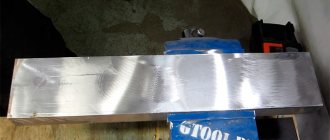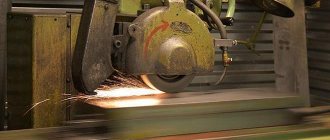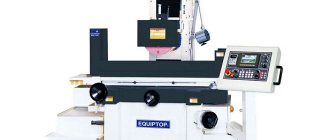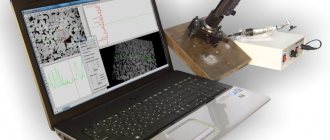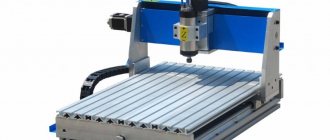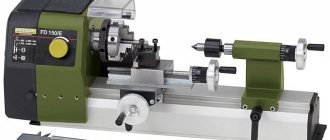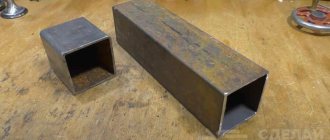A surface grinding machine is used to process the surface of metal products. The main purpose is the finishing and finishing of flat surfaces of products using diamond or abrasive wheels. Product blanks can be mounted on a magnetic plate or table mirror. The method of serving, longitudinal or circular, will depend on the shape of the table.
A flat metal surface can be polished with high precision using such a device. The degree of roughness corresponds to GOST and ranges from 0.63 to 0.16 micrometers after processing. After processing on such equipment, the surface cleanliness will correspond to class 9-10. For precision work and obtaining high-quality products, it is better to purchase a machine made at an enterprise than to assemble it yourself from scrap materials. A self-assembled device may take longer to process parts and will have greater accuracy.
General information
To process shaped surfaces, installation of additional equipment is required. Modern surface grinding machines are capable of processing even cone-shaped elements. All general purpose devices can be divided into categories:
- Manual devices.
- Semi-automatic devices that support active control of the operation of a desktop device.
Modern industry allows you to purchase various versions of devices, which will allow you to process parts of various shapes. To process the periphery of a circle, you will need a machine with a support, a horizontal spindle and a rectangular table.
Such a device is ideal for grinding the boundaries of the end surfaces indicated by the device casing. Typically, such devices are purchased for tool shops.
Universal machines with a rectangular table can have a horizontal and vertical spindle They are not characterized by the highest grinding accuracy, but they are characterized by high productivity due to the installed powerful electric motors, large grinding wheels and increased rigidity design. This is precisely the main difference from machines with a cross support.
How are electromagnetic plates demagnetized?
Having completed the grinding operation, the part is removed from the table. Its residual magnetization is eliminated. This is facilitated by the demagnetization operation. The precision of grinding on machines and their productivity come from the efficiency and quality of demagnetization methods. The main priority of demagnetization is easy removal of the processed part from the table.
Reducing the duration of demagnetization significantly increases labor productivity on the machine. For the total time of auxiliary-preparatory and final operations, part of the table demagnetization time is 8...20%. Therefore, it is necessary to strive to reduce this period.
Unlike electromagnetic tables, magnetic tables do not require an energy source to power them. Permanent magnets made of nickel-aluminum alloy serve as poles for them. They are magnetized on special devices. The attraction of parts by magnetic plates is weaker than electromagnetic plates.
Rice. 4 shows a general view of the magnetic table. On top it is equipped with iron plates 1 and 2. Non-magnetic gaskets 3 are installed between them. High-power permanent magnets move and alternately close on the iron plates and on the fixed part. Handle 4 switches the magnets. The bottom of the plate is attached to the table with bolts and clamps.
Rice. 4. Magnetic plate with permanent magnets: 1, 2 – iron plates; 3 – non-magnetic layers; 4 – handle; 5 – permanent magnets
A special demagnetizer is placed in automatic grinding machines. Its function is to demagnetize processed steel parts. In addition to electromagnetic and magnetic plates, workpieces are mounted on machines:
- mounting strips;
- universal clamps;
- pattern vice;
- special plates.
In Fig. Figure 5 shows a pattern vice. They are more precise than a simple vice and can also be turned.
The sidewalls in the pattern vice are parallel to each other and perpendicular to the base. The vice is fastened through threaded holes. They are often attached to a magnetic plate. The device is made of steel, hardened and ground on all sides. When installing parts on a magnetic plate, use installation tiles with strips. They greatly increase the reliability of fastening parts to the plate.
Rice. 5. Pattern vice for securing sanded workpieces: 1 – fixed jaw; 2 – measuring pin; 3 – movable sponge; 4 – body; 5 – screw
Grinding Techniques
When working on a surface grinding device, the following techniques can be distinguished:
- Multi-pass processing. This technique requires fixing the element on the surface. The speed of its movement during processing reaches 45 meters per minute. The processing method is reduced to repeatedly moving the product under the circle until the allowance is completely removed. In this case, the machine performs the last moves without feed or with a small vertical feed.
- Single pass processing. Used for machines with round tables. With this method, the machine passes vertically to its entire depth in one go. As a result, the entire allowance from the part is removed in one revolution. Devices with three heads allow you to remove large allowances with maximum grinding precision. Such devices are used mainly in mass production.
- Double-sided processing. This technology involves grinding two ends of a part at the same time. With this method, more than one pass of the product will be required to completely remove the allowance. The essence of the method is linear or circular feeding of the part. Due to the rotation of the tool, metal is cut. The periphery of the circle should be used to process products with medium hardness. With the end processing method, productivity will be higher than with the peripheral method.
Examples of surface grinding work
- Grinding of burrs. Burrs are various defects that occur when cutting metal. Due to the large surface area of the grinding wheel, grinding down burrs is the easiest way to remove them.
- Grinding of profits, sprues - the profit is the upper part of a metal ingot, which exceeds the required dimensions due to the fact that the cooling metal is fed with liquid melt during the solidification of the ingot. The sprues are both the tubes through which molten metal is fed, and the traces left by such tubes. To eliminate them, processing on a surface grinding machine is optimal, since this is the simplest and cheapest way to bring them to the desired shape.
- Removing allowances. Allowances are specially formed remnants of material that are easier and cheaper to remove by grinding than by bringing them to the exact size directly on manufacturing equipment.
- Polishing of welds and flashes is excess metal that appears along the weld line or along the parting line of the casting mold. They are also much easier to sand down than to try to remove with a milling machine.
Methods for grinding with the periphery of a wheel
Existing grinding methods:
- Deep method. This method allows you to remove significant allowance from parts with each stroke. In this case, the minimum longitudinal feed speed is noted. With this method, rapid abrasion of the wheel is observed due to the weight of removal on the abrasives located at the end.
- Continuous feed method. This method is used for processing products whose height is greater than their width, and the surface being processed has edges. This method is characterized by low operating accuracy and the absence of transverse feed. The master has to constantly adjust the machine due to uneven wear of the tool.
- Method with transverse intermittent feed. This method allows for high-quality processing of parts. This method is used for surface grinding machines with a horizontal spindle and a round table. This technique is characterized by high accuracy. The height of the grinding tool should be higher compared to the cross feed.
Surface grinding machines KAMIOKA and L&W
In the Surface Grinding Machines section, precision surface grinding machines from Asian manufacturers KAMIOKA and L&W are always on sale. We chose these manufacturers because of the high quality of their equipment at relatively low prices. The section provides an overview and comparative description of the main parameters of the presented machines - their dimensions, movement parameters, engines. For more detailed information, you can go directly to the machine cards or contact our specialists for advice by phone or by mail
Design features of the equipment
The machine is a device with a cast frame mounted on a stand with a bed cast in the form of a solid tool. Vertical guides are located on the sides of the opening in the center of the frame. For hydraulic or manual movement of the grinding head there is a moving carriage with guides. This arrangement allows you to increase the rigidity of the unit.
Kinematic short chains ensure stable feeding. On the device they look like a rolling nut, a screw and guides. The vertical movement of the grinding headstock and carriage is ensured by a special automatic device, which is mounted on the front wall of the bed.
Rapid vertical movement is ensured by a similar mechanism located behind the machine. Among the main elements of a surface grinding machine are: guard blocks, locking mechanisms, rebound devices (in case of failure of the grinding head). All these devices allow you to work with the machine at the proper level of safety.
Basic machine parameters
When purchasing a metal grinding machine, you should pay attention to the following parameters:
- Table size.
- The rotation speed of the grinding wheel and its diameter.
- Grinding method: with the periphery or the end of the wheel.
- Machine power.
- Supply voltage.
- Work table size.
- Diameter of grinding tool.
- Nominal speed.
- Dimensions.
- Machine weight.
- Price.
An assessment of these parameters is necessary depending on the purpose of the device (for personal use or industrial work) and the required amount of processing of parts.
Movement along the axes of surface grinding machines
- Axes - on most surface grinding machines, movement along the X (longitudinal movement), Y (transverse movement) and Z (vertical movement) axes is possible. The standard and most ergonomic is the movement of the worktable in the longitudinal and transverse plane, and the movement of the spindle in the vertical plane. Of course, other options are possible. In addition, there are models with additional axes - for example, rotation of round work tables, tilting tables, etc.
- Amount of movement - the amount of movement shows how much the table can move along a particular axis. The greater the possible movement, the more possibilities for machining the part or workpiece.
- Methods - the table and spindle can be moved either manually - using a flywheel, or automatically - using various motors. Manual movement along the axis makes the machine cheaper both to purchase and to operate. In most cases, automatic feeding is duplicated by the possibility of manual feeding, since, other things being equal, manual control is more accurate. At the same time, constant manual control leads to greater operator fatigue and more errors.
- Graduation - graduation is applied to the handwheel, and shows how many divisions of the flywheel you need to turn the flywheel wheel so that the table or spindle moves along the desired axis to the required distance. The smaller the graduation, the more accurate the operations of the surface grinding machine.
- Movement speed - two factors depend on the movement speed: the lower the minimum speed, the more thorough processing of the part is possible. High speed is important for roughing and roughing of parts, for multi-pass processing to return the part to the starting position for a new pass, and for frequent changes of parts.
Machine repair and modernization
During operation and production of parts put into production, all mechanisms begin to wear out over time . Parts are replaced after the service life of each specific element has expired. This attitude towards equipment increases the accuracy of work and personnel safety. Machines are subject to major overhaul after twenty years of operation.
The manufacturer provides a service life warranty for each element of the machine, but depending on the workload of the equipment, replacement may be required earlier. Modernization of equipment makes it possible to increase the number of parts produced.
Types and features
Three modifications are offered for consideration, most applicable to home needs.
Surface grinder JET 16-32 Plus. This machine has excellent technical parameters, which are more than enough for household use and for minor repair work. The accuracy of surface finishing of a part can reach 10 fractions of a micron.
The machine consumes power at the level of 2 kilowatts, which is also acceptable for home working conditions, because not every electrical network can support the operation of a 10...15-kilowatt unit. Small dimensions and weight (61 kg). The characteristics of the main work are as follows:
Surface grinder PROMA RVR-400A. This is already the level of professional equipment, equipped with CNC. There is a working surface that is designed for a fairly significant load (350...380 kg), which will allow processing large-sized semi-finished products. The power of such a machine is 10 kW. Has the following operating parameters:
- 1100 mm – maximum possible longitudinal feed;
- 240 mm – possibility of cross feed;
- 550 mm – maximum lift of the “working body” above the bed.
This example is given more as an example, because equipment weighing almost 4 tons is needed in a production environment, and not in a home workshop.
Surface grinding mechanism LSh-322. The manufacturer of this equipment presents it as a machine for small repair rooms. Just what we need. The machine has small dimensions - 1050 × 1000 × 1800 mm, weight 700 kilograms. Significantly more compact than the previous model.
It has excellent characteristics regarding processing accuracy - maximum deviations are in the region of 3...5 microns, and roughness is 0.16 microns. Still, for household needs, this mechanism is expensive (its price is about $15,000) and also massive.
Video: homemade surface grinding machine.
How to make a grinding machine yourself
For home use, you can make the machine yourself if you have the available parts. The grinder is the most common model for home use. Its structure and assembly method are extremely simple. For assembly you will need the following parts:
- The frame is made of thick metal corners.
- Engine.
- Rollers in the amount of 4 pieces.
- Springs - 2 pieces.
- Sanding tape.
The inconvenience of using this device for permanent use is the constant stretching of the tape. To regulate the tension of the tape, install springs and use the handle to adjust their length. The handle also serves as a lifting bar for one roller.
Installing crossbars together with such a device allows you to replace the tape less frequently. If the rollers are made of titanium or durable steel, then they will not require replacement. The roller bushings are secured to the frame with strong bolts until they are stationary. The rotating part of the roller is made according to the bearing principle.
Such a machine in your home arsenal will allow you to process metal and wood products. When assembling the machine yourself, special attention should be paid to the engine power. The motor power from the washing machine is enough to process wood. This device can be used to sharpen and polish home tools. To process products that require high precision grinding, it is better to purchase a factory-made machine.
Motors (drives) of surface grinding machines
- Motor types - electric, hydraulic, servo drives. All engines are powered by electricity. The purpose of hydraulic drives is to smoother movement of the work table or spindle; they are often used for longitudinal movement of the table. The purpose of servos is to maintain a constant speed of small movements for a long time, so they are more often used when the spindle moves vertically.
- Motor power - the power of the motors determines how much weight and at what speed they can move parts and workpieces. The more powerful the engine, the more electricity it requires.
Disadvantages of my grinding machine
We recommend reading our other articles
- The practicality and benefits of purchasing corn seeds from a reliable and trusted supplier
- Wireless charging for iPhone - a stylish and practical solution
- Features of choosing household air conditioners
- Features and rules for choosing wires for arranging the power supply system
Practice has shown that the machine has the following disadvantages:
- When I got used to the machine, I realized that a 380 W motor was not enough, now I plan to convert the machine to a 1 kW motor. A machine with this engine allows you to sharpen wooden, plastic, and plywood blanks, but does not allow you to grind, for example, large boards and bars. Metal on this sharpening and grinding machine can be processed with a thickness of up to 2-3mm, a corner with a thickness of 4-5mm is already quite tedious to grind. It all depends on the goals, for me the machine performs 90% of the goals perfectly, but when I need to grind a large workpiece, there is not enough power...
- Sometimes the speed controller is missing, this can be solved by connecting a frequency converter.
- Rearranging a wheel with sandpaper takes about 5 minutes - you need to remove 2 casings and a table, and then unscrew the wheel with sandpaper - for some this is “5 minutes of work”, but for me it’s inconvenient when you need to sharpen something with finer sandpaper, but then work again with coarse sandpaper. For small jobs I use a universal machine with a drill chuck. Otherwise, it would be convenient to attach the emery to the circle with Velcro, or I’ll just make a second machine with a 1 kW motor for large jobs, and leave this one for smaller jobs.
- As I said above, replacing the sandpaper on a wheel is quite difficult - you need to tear off the old sandpaper, you can use heat or make a Velcro fastening. Although Velcro may have its drawbacks - I have not seen sandpaper for Velcro sold in our city - only small circles for a drill, and it can also fall off over time, because will become clogged with sawdust. And replacing the sandpaper on the wheel is not necessary so often - only once every few months.
- When processing wood there is a lot of dust, you need to connect a vacuum cleaner, so I started installing covers on the machine.
Types and features
Three modifications are offered for consideration, most applicable to home needs.
Surface grinder JET 16-32 Plus. This machine has excellent technical parameters, which are more than enough for household use and for minor repair work. The accuracy of surface finishing of a part can reach 10 fractions of a micron.
The machine consumes power at the level of 2 kilowatts, which is also acceptable for home working conditions, because not every electrical network can support the operation of a 10...15-kilowatt unit. Small dimensions and weight (61 kg). The characteristics of the main work are as follows:
Surface grinder PROMA RVR-400A. This is already the level of professional equipment, equipped with CNC. There is a working surface that is designed for a fairly significant load (350...380 kg), which will allow processing large-sized semi-finished products. The power of such a machine is 10 kW. Has the following operating parameters:
- 1100 mm – maximum possible longitudinal feed;
- 240 mm – possibility of cross feed;
- 550 mm – maximum lift of the “working body” above the bed.
This example is given more as an example, because equipment weighing almost 4 tons is needed in a production environment, and not in a home workshop.
Surface grinding mechanism LSh-322. The manufacturer of this equipment presents it as a machine for small repair rooms. Just what we need. The machine has small dimensions - 1050 × 1000 × 1800 mm, weight 700 kilograms. Significantly more compact than the previous model.
It has excellent characteristics regarding processing accuracy - maximum deviations are in the region of 3...5 microns, and roughness is 0.16 microns. Still, for household needs, this mechanism is expensive (its price is about $15,000) and also massive.
Video: homemade surface grinding machine.
Review and characteristics of popular models
- PBP-250 Proma. The machine is designed to work with workpieces whose weight does not exceed 200 kg. The low level of electricity consumption and a fairly high table area make the device the optimal choice for private workshops and medium-sized metalworking enterprises. Country of origin: China. The warranty period is 3 years. Specifications:
Surface grinding machines allow you to obtain a perfectly flat surface without any defects. There is an opinion among turners that for home use it is better to make the unit yourself: processing accuracy can be sacrificed due to significant savings. What do you think? What is better for the home: a homemade machine or a compact factory machine? Share your opinion in the comments block.
Comparison
Depending on the position of the spindle, grinding can occur either with the plane (end) of the wheel or with the periphery.
When working with the entire plane, in addition to increased wear of the distal part of the circle, difficulties arise with chip removal. Particles cut off by the central part of the abrasive cannot immediately leave the grinding site. Rolling between the circle and the surface, they leave deep scratches on the metal. To improve the results, the disk of the surface grinding machine can be fixed with eccentricity, or the part can be ground in several passes, gradually shifting the center of the working attachment.
When working on the periphery of a circle, there are no problems with chip removal, but another feature arises: processing a large area is possible only in several passes. During operation, the circle wears out and its diameter decreases. It is important to take this reduction into account when re-setting the feed depth every few passes.
Features of vertical spindle
The vertical position of the spindle allows you to use the entire surface of the abrasive wheel.
However, when processing metal, a difference arises in the linear speed of abrasive particles near the center of the circle and at its periphery. The outer areas of the circle experience more friction and cut off more metal as the job begins. During operation, it is the outer part of the wheel that wears out faster - gradually the working part of the abrasive ceases to be flat and begins to leave noticeable stripes on the metal. In order for the result of processing on a machine with a vertical spindle to be predictable, it is necessary to monitor the wear of the working surfaces of the abrasive and replace it in time. Another effective way is to reduce the abrasive feed and process the workpiece in several passes.
